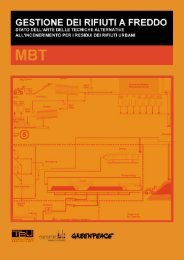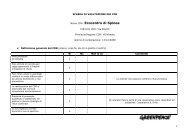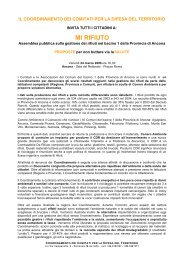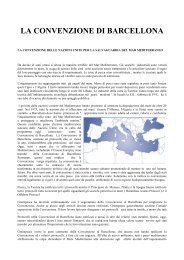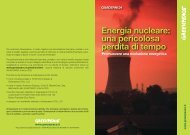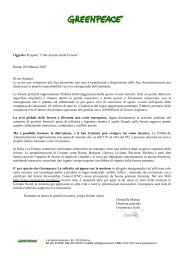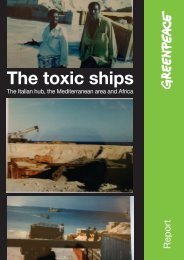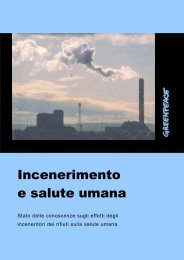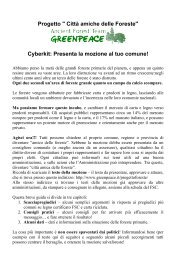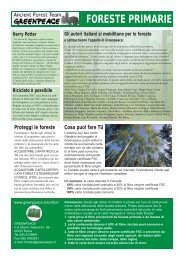Zero Waste by Robin Murray, Greenpeace Environmental Trust 2002
Zero Waste by Robin Murray, Greenpeace Environmental Trust 2002
Zero Waste by Robin Murray, Greenpeace Environmental Trust 2002
You also want an ePaper? Increase the reach of your titles
YUMPU automatically turns print PDFs into web optimized ePapers that Google loves.
challenge comes when the cause of the emissions cannot<br />
be ascribed to a single plant but to the product chain as a<br />
whole. Can the UK climate change measures be widened<br />
to take in such product chain issues and waste<br />
reduction/resource productivity more generally?<br />
The question can be posed first in relation to emissions<br />
trading. For such trading to work, firms have to register<br />
current emission levels and agree targets for their<br />
reduction. There have been 44 agreements in the UK to<br />
date, and there is a view that the existing criteria of<br />
eligibility that allows firms to trade reduction targets for<br />
tax concessions should be widened. Under the likely terms<br />
of the international trade in permits, once a reduction<br />
target is agreed a firm (or country) will have the option to<br />
meet it <strong>by</strong> emissions reduction, sequestering carbon or <strong>by</strong><br />
buying credits. As a result major GHG emitters in North<br />
America are already preparing for the new trading regime<br />
<strong>by</strong> investing in projects that will promote sequestration or<br />
large emissions reductions (such as forestry and<br />
agriculture) and hence offset their own shortfalls.<br />
With respect to waste and materials, it should be possible<br />
in principle for firms, either individually or as a product<br />
chain pursuing the Design for Environment Strategies<br />
outlined in Table 8, to register their current CO2 emission<br />
levels and reduction targets and to generate surplus<br />
certificates for sale. Given that the price of the certificates<br />
when they are internationally traded is forecast to be<br />
substantial, this would provide a major incentive for the<br />
adoption of industrial <strong>Zero</strong> <strong>Waste</strong> policies. The issue is<br />
whether the registration and target regime in the UK can<br />
take such policies into account. How could the benefits of<br />
substituting biodegradable plastics for oil-based plastics be<br />
included in the scheme; or the production of a fully<br />
recyclable car with a thirty-year lifespan?<br />
Similar questions could be asked of other parts of the UK’s<br />
fiscal package: could such material productivity initiatives<br />
be granted the Climate Change levy reductions in re t u rn for<br />
an agreement covering material efficiency as well as energ y<br />
e fficiency improvements? Could firms that provide lifelong<br />
guarantees on products with take-back agreements qualify<br />
for the extra capital allowances? Could those firms which<br />
a g ree to standardise components to ease re m a n u f a c t u re and<br />
repair receive funding from the Carbon <strong>Trust</strong>?<br />
The answers to these questions must in principle be yes.<br />
<strong>Waste</strong> minimisation and materials efficiency agreements<br />
could be replicated on the model of those for energy<br />
efficiency, and indeed would overlap. But, as with the<br />
producer responsibility approach, the challenge comes<br />
when no one firm can make the necessary changes on its<br />
own. In such cases, the agreements and incentives need to<br />
be collective.<br />
Instruments of the information economy<br />
A third approach sees the generation, interpretation and<br />
distribution of information as the critical point of entry<br />
for <strong>Zero</strong> <strong>Waste</strong> policy. The starting point for any reorientation<br />
of productive practices, it argues, is to make<br />
their current environmental impact visible. Where<br />
economists have sought to marketise environmental costs<br />
and benefits which have been hitherto outside the market,<br />
so in parallel the same thing needs to happen with<br />
environmental information, to make visible what has<br />
hitherto remained unseen.<br />
In relation to <strong>Zero</strong> <strong>Waste</strong> this entails the qualitative and<br />
quantitative study of the impact of diff e rent types of<br />
p roduct and productive system on the environment and an<br />
assessment of how they can be improved. In the past thirt y<br />
years this has generated a wide range of new ways of<br />
looking at the material flows of the economy and their<br />
e ffects. (The ex post quantification of material flows is one<br />
example, along with life cycle analysis and dynamic ex ante<br />
estimates of flows and processes to judge the impact of<br />
a l t e rnative paths of technical change.) It has also generated<br />
new ways of counting (through the development of<br />
e n v i ronmental re p o rting and perf o rmance indicators) and a<br />
new level of scientific testing of hazardous effects.<br />
178<br />
<strong>Zero</strong> <strong>Waste</strong><br />
179



